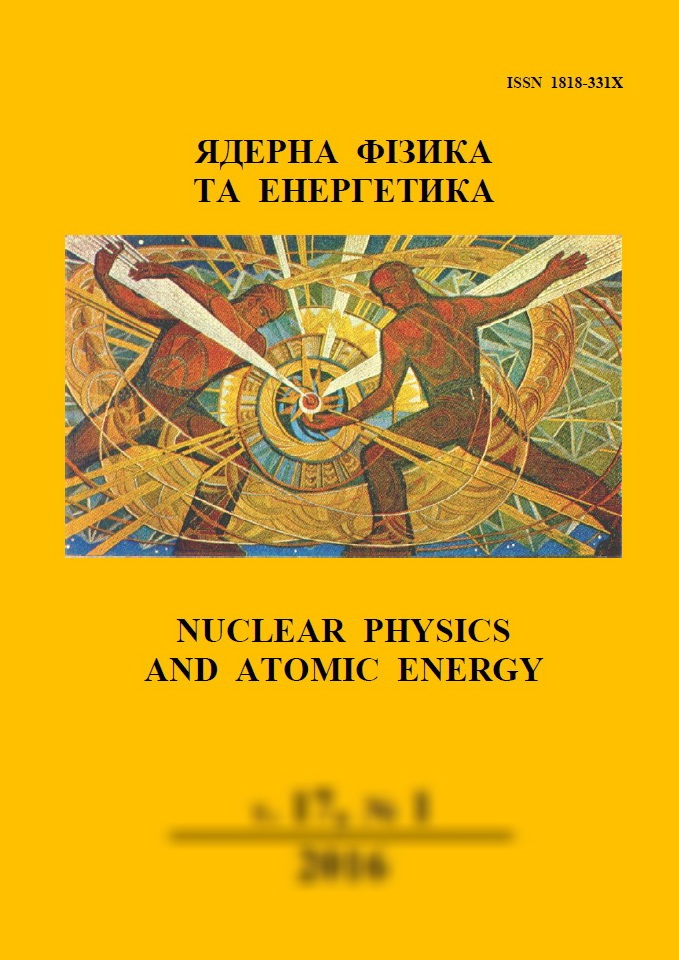 |
Ядерна фізика та енергетика
Nuclear Physics and Atomic Energy
ISSN:
1818-331X (Print), 2074-0565 (Online)
Publisher:
Institute for Nuclear Research of the National Academy of Sciences of Ukraine
Languages:
Ukrainian, English
Periodicity:
4 times per year
Open access peer reviewed journal
|
Nucl. Phys. At. Energy 2006, volume 7, issue 2, pages 7-15.
Section: Nuclear Physics.
Received: 04.07.2006; Published online: 30.12.2006.
 Full text (ru)
Full text (ru)
https://doi.org/10.15407/jnpae2006.02.007
Nuclear g-factors and structure of the high-spin isomers in 190,192,194Pt
A. I. Levon, I. B. Kovgar, Yu. V. Nosenko, V. A. Onischuk, A. A. Schevchuk
Institute for Nuclear Research, National Academy of Sciences of Ukraine, Kyiv, Ukraine
Abstract:
Integral perturbed angular distribution method in an external magnetic field has been used to measure the g-factors
of isomers in the 190,192,194Pt, populated in the (α, 2n)-reaction. The results are as follows: 190Pt, g(12+) = -0.17(12), g(10-) = -0.0016(36), g(7-) = +0.62(9); 192Pt, g(12+) = -0.18(9), g(10-) = -0.0012(10), g(7-) = 0.48(12); 194Pt, g(12+, new assignment) = 0.17(7), g(7-) = +0.26(8). The 12+ states have the rotational-aligned (νi -213/2) structure. The missing rotation-aligned (νi-213/2)12+ state is suggested to be isomeric in 194Pt (instead of the 10+ state) and to which the g = -0.17(6)
value has to be attributed. From the g-factors of the 10- states in 190Pt and 192Pt, which have the configuration ν9/2-[505]⊗ ν11/2+[615], the anomalous gl-factor for neutrons has been derived as δgl = -0.028(6). Positive values of g-factors of the 7- isomers confirm the prediction of the non-axial rotor + 2 quasiparticles model about the change of the
intrinsic structure from mainly (νi13/2, νj) to mainly (πh11/2, πj) in transition from Hg to Pt nuclei.
References:
1. Sergolle H., Aguer P., Bastin G. et al. Z. Phys. A 313 (1983) 289.
https://doi.org/10.1007/BF01439480
2. Hjorth S. A., Lee I. Y., Beene J. R. et al. Phys. Rev.
Lett. 45 (1980) 878.
https://doi.org/10.1103/PhysRevLett.45.878
3. Kroth R., Bhettacherjee S. K., Günther Ch. et al. Phys. Lett. B 97 (1980) 197.
https://doi.org/10.1016/0370-2693(80)90581-X
4. Gorbachev B. I., Levon A. I., Nemets O. F. et al. Yad.
Fiz. (Sov. J. Nucl. Phys.) 39 (1984) 518.
5. Piiparinen M., Cunnane J. C., Daly P. J. et al. Phys.
Rev. Lett. 34 (1975) 1110.
https://doi.org/10.1103/PhysRevLett.34.1110
6. Hjorth S. A., Johnson A., Lindblad Th. et al. Nucl.
Phys. A 262 (1976) 328.
https://doi.org/10.1016/0375-9474(76)90625-4
7. Cunnane J. C., Piiparinen M., Daly P. J. et al. Phys.
Rev. C 13 (1976) 2197.
https://doi.org/10.1103/PhysRevC.13.2197
8. Levon A. I., de Boer J., Pozdnyak R. S. et al. Europ.
Conf. on Advances in Nucl. Phys. and Related Areas (Thessaloniki, Greece, 8 - 12 July, 1997).
9. Левон A. И., Немец O. Ф. Электромагнитные моменты возбужденных и радиоактивных ядер (Київ: Наук. думка, 1989) c. 471.
10. Browne E., Singh B. Nucl. Data Sheets 79 (1996) 277.
https://doi.org/10.1006/ndsh.1996.0013
11. Shirley V. S. Nucl. Data Sheets 64 (1991) 205.
https://doi.org/10.1016/S0090-3752(05)80015-8
12. Singh B. Nucl. Data Sheets 61 (1990) 243.
https://doi.org/10.1016/S0090-3752(05)80117-6
13. Funke L., Kemnitz P., Winter G. et al. Phys. Lett. B 55 (1975) 436.
https://doi.org/10.1016/0370-2693(75)90549-3
14. Frauendorf S. Phys. Lett. B 100 (1981) 219.
https://doi.org/10.1016/0370-2693(81)90320-8
15. Yadav H. L., Toki H., Faessler A. Phys. Rev. Lett. 39 (1977) 1128.
https://doi.org/10.1103/PhysRevLett.39.1128
16. Jones G. A., Podolyak Zs., Schunck N. et al. Acta
Phys. Polonica B 36 (2005) 1323.
17. Kroth R., Hardt K., Guttormsen M. et al. Phys. Lett. B 99 (1981) 209.
https://doi.org/10.1016/0370-2693(81)91109-6
18. Yadav H. L., Faessler A., Toki H. et al. Phys. Lett. B 39 (1980) 307.
https://doi.org/10.1016/0370-2693(80)90130-6
19. Harmetz B., Handley T. H. Nucl. Phys. 56 (1964) 1.
https://doi.org/10.1016/0029-5582(64)90451-1
20. Ohya S., Ohtsubo T., Kometsuzaki K. et al. Phys.
Rev. C 54 (1996) 1129.
https://doi.org/10.1103/PhysRevC.54.1129
21. Stuchbery A. E., Anderssen S. S., Bolotin H. H. et al. Nucl. Phys. A 342 (1992) 373.
https://doi.org/10.1007/BF01294946
22. Schütz G., Hagn E., Kienle P. et al. Phys. Rev. Lett. 56 (1986) 1051.
https://doi.org/10.1103/PhysRevLett.56.1051
23. Bodenstedt E., Hamer B., Herzog P. et al. Z. Phys. A 342 (1992) 249.
https://doi.org/10.1007/BF01291506
24. Stuchbery A. E., Lampard G. J., Bolotin H. H. Nucl.
Phys. A 528 (1991) 447.
https://doi.org/10.1016/0375-9474(91)90098-Q
25. Yamazaki T. Mesons in Nuclei 2 (1979) 651.
26. Bengtsson R., Bengtsson T., Dudek J. et al. Phys.
Lett. B 183 (1987) 1.
https://doi.org/10.1016/0370-2693(87)91406-7
27. Raman S., Nestor J., Kahane S. et al. At. Data Nucl.
Data Tables 42 (1989) 1.
https://doi.org/10.1016/0092-640X(89)90031-4
28. Jain A. K., Sheline R. K., Sood P. C. et al. Rev. Mod.
Phys. 62 (1990) 393.
https://doi.org/10.1103/RevModPhys.62.393
29. Yamazaki T. Phys. Lett. B 60 (1985) 227.
https://doi.org/10.1080/00357529.1985.11764412
30. The European Muon Collaboration. Phys. Lett. B 123 (1983) 275.
https://doi.org/10.1016/0370-2693(83)90437-9
31. Toki H., Neergård K., Vogel P. et al. Nucl. Phys. A 279 (1977) 1.
https://doi.org/10.1016/0375-9474(77)90417-1
32. Neergård K., Vogel P., Radomski M. Nucl. Phys. A 238 (1975) 199.
https://doi.org/10.1016/0375-9474(75)90349-8
